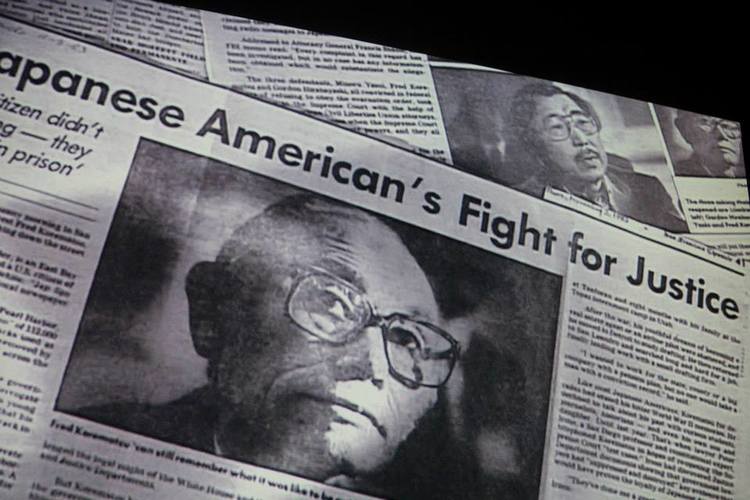Korematsu v United States: A Chronology

January 30, 1919
Fred Korematsu is born in Oakland, California.
1940
Korematsu registers for the draft, but is classified as 4-F because of a gastric ulcer. Korematsu attends welding school and gets a job in a shipyard in San Francisco.
December 7, 1941
Japan attacks Pearl Harbor. The FBI arrests 1,300 Issei (first-generation Japanese immigrants), out of concern some might be dangerous enemy aliens.
January 5, 1942
Nisei (Americans whose parents were Japanese immigrants) are reclassified as aliens ineligible for the draft.
February 19, 1942
President Roosevelt signs Executive Order 9066, authorizing the forced exclusion of all persons of Japanese ancestry from a West Coast military exclusion zone.
March 4, 1942
Korematsu undergoes plastic surgery, at the urging of his girlfriend, in an effort to disguise his Japanese features and remain in the exclusion zone.
March 21, 1942
Congress enacts legislation (Public Law 503) making it a crime to violate military orders issued pursuant to Executive Order 9066.
March to August, 1942
All persons of Japanese ancestry on the West Coast (over 110,000 people in all) of the United States are forced to leave their homes and businesses and move to temporary detention (assembly) centers, from which they will later be relocated to internment camps.
May 3, 1942
Civilian Exclusion Order No. 34 is issued ordering exclusion of persons of Japanese ancestry from the area where the Korematsu family resided.
May 8, 1942
Fred’s family reports to the Tanforan Assembly Center in San Bruno, as ordered. They become “family 21538.” Fred does not report.
May 30, 1942
Fred Korematsu is arrested in San Leandro, California.
June 12, 1942
Formal charges are filed against Fred for remaining in the military exclusion zone in violation of Order No. 34.
June 18, 1942
Military police take Fred to the Tanforan Assemby Center, where he is housed in a space formerly used as a horse stall.
September 8, 1942
Fred is tried and found guilty as charged in the United States District Court for the Northern District of California. The government presents only one witness, the FBI agent who interviewed Fred. The government also introduces Fred’s statements, his altered draft card, and his birth certificate.
September 28, 1942
Korematsu is moved to the Relocation Center (concentration camp) at Topaz, Utah.
January 28, 1943
Nisei are permitted to volunteer for military service.
February 19, 1943
Ninth Circuit hears oral argument from counsel for Korematsu and two other Japanese-Americans (Minoru Yasui, and Gordon Hirabayashi).
March 1943
Korematsu is allowed to work at a pipe construction company in Tooele, Utah, though he still had to report back to the Topaz camp.
May 30, 1943
Korematsu is issued a short-term leave permit to work in Salt Lake City.
June 1, 1943
The Supreme Court announces its opinion in the Hirabayashi and Yasui cases, and says it could hear Korematsu’s appeal. In Hirabayashi, the Court upholds the constitutionality of a curfew order affecting Japanese-Americans.
December 2, 1943
The Ninth Circuit affirms Korematsu’s conviction.
January 1944
The government grants Fred’s application for indefinite leave from Topaz. Later in the year, Fred heads further east, first to Chicago and then, by October, to Detroit. While on probation, he is still prohibited from returning to the West Coast.
February 2, 1944
A petition for certiorari in Korematsu’s case is filed with the Supreme Court.
March 27, 1944
Certiorari is granted in Korematsu v United States.
October 11, 1944
Oral arguments are heard in the Korematsu case.
December 17, 1944
The War Department announces that Japanese Americans who have passed loyalty screening are free to leave camps after January 2, 1945.
December 18, 1944
The Supreme Court announces its opinion in Korematsu v United States. The Court upholds the constitutionality of Executive Order 9066 and the Army’s exclusion of Japanese-Americans. The same day, in Ex Parte Endo, the Court rules that the government cannot detain Japanese-American citizens whose loyalty to the U.S. had been established.
May 28, 1945
Fred’s parents return to Oakland from Topaz.
August 11, 1945
V-J Day -- Japan surrenders.
October 12, 1946
Fred marries Kathryn Pearson in Detroit.
February 19, 1976
President Gerald R. Ford issues Proclamation 4417 repealing Executive Order 9066.
July 31, 1980
President Jimmy Carter signs legislation establishing the Commission on Wartime Relocation and Internment of Civilians to investigate incarceration of Japanese Americans during World War II.
January 19, 1983
Korematsu’s legal team files his petition for a writ of error coram nobis.
February 1983
The Commission on Wartime Relocation issues report entitled “Personal Justice Denied.”
November 10, 1983
Judge Marilyn Hall Patel holds a hearing on Fred's petition. She overturns Fred’s criminal conviction.
April 19, 1984
Judge Patel issues her formal written opinion overturning Korematsu’s conviction.
August 10, 1988
President Ronald Reagan signs the Civil Liberties Act. The law provides an apology from the government and redress of $20,000 to each survivor incarcerated under Executive Order 9066.
January 15, 1998
Korematsu receives the Presidential Medal of Honor from President Bill Clinton.
March 30, 2005
Fred Korematsu dies at the age of 86.
September 23, 2010
Governor Arnold Schwarzenegger signs legislation recognizing Fred’s birthday as “Fred Korematsu Day of Civil Liberties and the Constitution” in California.
June 25, 2018
Writing for the Supreme Court in Trump v Hawaii, Chief Justice John Roberts declares: “The forcible relocation of U.S. citizens to concentration camps, solely and explicitly on the basis of race, is objectively unlawful and outside the scope of presidential authority.” He writes, “Korematsu was gravely wrong the day it was decided, has been overruled in the court of history, and — to be clear — ‘has no place in law under the Constitution.’”
